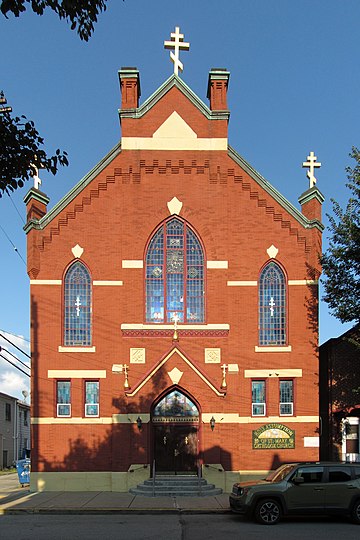
-
Tabernacle of the Union Baptist Church, South Side

This is a kind of machine-age Gothic, all sharp angles instead of the tapered points of more traditional Gothic forms. Built in 1881, this is no longer used as a church, but the exterior has been lovingly preserved.
-
Sarah Street, Between 19th and 20th

Streetscape of Sarah Street, with typical South Side rowhouses, a small synagogue, and the South Side Presbyterian Church at the end of the block.
-
Holy Assumption of St. Mary Orthodox Church, South Side

Clearly this was built as a Protestant church, but the Orthodox congregation has been here for quite some time now. Here we see the west front in the warm rays of the evening sun.
-
Splendidly Victorian

Even on a splendidly Victorian street like Carson Street on the South Side, this building stands out as unusually ornate.
-
French Marigolds

Old Pa Pitt uses various digital cameras that are cheap, old, or both; but when the desired effect is to make a foreground object stand out from the blurred background, it helps to have a DSLR. It helps even more to have a DSLR with a supplementary macro lens, which gives us a very shallow depth of field. The camera that took these pictures is an Olympus E-20n, which is old enough to vote and next year will be old enough to drink. But as long as it keeps taking pictures like these, old Pa Pitt will keep it in the camera bag.


-
Herron Hill Pumping Station

Why shouldn’t a water-pumping station look like a Roman basilica? It’s what the Romans would have done. This substantial building was designed by William Smith Fraser, and it has its own appropriately substantial Wikipedia article. Unfortunately the Pittsburgh Water and Sewer Authority has thought it necessary to brick up the windows, so that what used to be an airy temple of technology must be like a tomb inside now.
-
Gailliot Center for Newman Studies

There is still at least one architect in Pittsburgh who can work in the Gothic idiom with modern materials. His name is David J. Vater, and he designed this building on Dithridge Street (which opened in 2007) and the Ryan Catholic Newman Center around the corner on Bayard Avenue. His listing on Porch.com has this to say about his firm: “Based in Pittsburgh, David J Vater Ra is an architectural firm that provides bathroom design, site planning, and master planning as well as other services.” The fact that bathroom design is mentioned first suggests that the demand for grand Gothic institutional buildings is low.
2 responses


